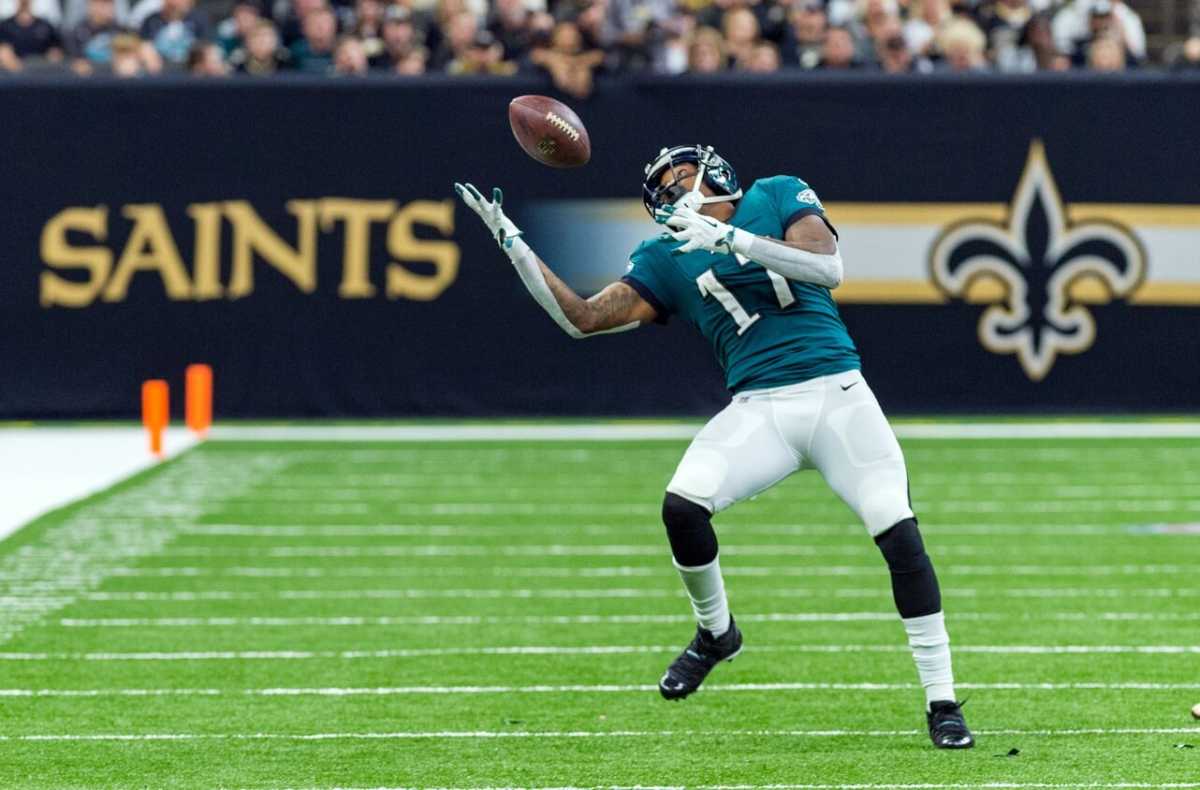It’s been three weeks since the Eagles shipped away a third-round pick to acquire Golden Tate from the Detroit Lions. Despite efforts to feed the explosive new recruit, the entire offence has been grasping at straws over those weeks. The Birds have only managed 17.3 points per game in that stretch, which would put them 29th in the NFL if that were the trend over the entire season. Their total performance over the length of the season hasn’t been much better — averaging 20.9 points per game, 23rd in the NFL. They have only managed to put up more than 24 points twice this season, both against the Giants’ 25th ranked scoring defense. This is a far cry from last season, in which Philadelphia managed a 3rd best 28.6 points per game.
Every Eagles’ fan and their dog has an opinion in what is wrong with the offence. Whether blame falls on Doug Pederson, Mike Groh, the running game, Carson Wentz not being fully healthy, injuries — the list goes on — the answer is just as controversial. Regardless of the ultimate solution, there are certain puzzles that must be resolved if this team is to make a playoff run. The first is the run game, a question that has prompted numerous articles from myself and other Eagles’ writers, and one that has at least been superficially solved by the emergence of undrafted rookie free agent Josh Adams. Many would believe the next bullet point on the docket is getting the new addition involved.
On the contrary, forcing the ball to Tate has been a hindrance for the Eagles offense. Instead, Doug Pederson and Mike Groh need to focus their attention on reintroducing a familiar face to the offence. Alshon Jeffery has all but disappeared since Tate’s arrival. In his five games before the trade, Alshon averaged 8.8 targets, 5.8 receptions and 68 yards per game. After? He has only commanded 5.3 targets, 3.7 receptions and 40 yards per contest. These are nowhere near the numbers the team would like to have from their top receiver. The numbers tell a tale of two tapes. Below are his stats in his first four games of the season in relation to the last four.
| Receptions | Targets | Yards | Yards/Reception | Touchdowns | |
| First 4 Games | 25 | 39 | 306 | 12.24 | 4 |
| Last 4 Games | 15 | 21 | 155 | 10.33 | 0 |
The argument could be made that Jeffery has been criminally underused since his arrival in Philadelphia. Having too many mouths to feed is generally a good problem for an offence to have. Nonetheless, without productive management of targets, the result can be less than a sum of its parts. The Eagles’ offence has been the embodiment of this conundrum since adding Tate. Torrey Smith was able, quite productively so, to play second — fourth — fiddle to Jeffery, Zach Ertz and Nelson Agholor without eating into their target share. Golden is used to being a number one receiver, and getting the attention of one. No wonder Groh has found it difficult to ‘integrate’ him into the offence. The coaching staff will have to set their priorities heading into the final stretch of the 2018 season. Here is the case for Alshon being priority one on that list:
Firstly, it is evident that the offence has had no trouble getting Ertz the ball so far this season. This article is written on the assumption that this trend continues. The Eagles gave Jeffery a four-year $52 million dollar contract last season. While it is not the richest contract for a receiver, it is nothing to scoff at. So far, they haven’t gotten their money’s worth. This is namely due to targets. The difference in Alshon’s target share between 2017 and 2018 is minimal — 0.7%. In fact, in both seasons he has averaged 7.5 targets per game. To get to the root of the issue, the underlying distinction must be made in the type of targets Alshon is drawing.
The Eagles haven’t had a receiver quite like Jeffery since Terrell Owens — meaning a jump ball specialist that can overpower and out-muscle opposing defenders. Alshon makes his bread and butter coming down with receptions he had no business coming down with. The 2017 coaching staff understood this. They were willing to sacrifice quality of target for big payoffs. Numbers comparing his production from last year to this year highlight exactly that. In calculating Alshon’s stats from 2017, I have subtracted the final two games of the season, in which he received a total of four targets, one reception and eight yards in two relatively meaningless games. These two games significantly skew the numbers and there have been no easily comparable games in 2018.
| G | Rec/G | Yds/Rec | Yds/G | TD | True Ctch Rate | Drop Rate | Contested Ctch Rate | Cont Tgts | Catchable Tgt Rate | Avg Tgt Distance | QBR | |
| 2017 | 14 | 4.0 | 14.0 | 55.8 | 9 | 67.5% | 6.7% | 43.8% | 32 | 67.5% | 14.6 | 90.6 |
| 2018 | 8 | 5.0 | 11.5 | 57.6 | 4 | 90.0% | 3.3% | 52.9% | 17 | 90.0% | 10.5 | 111.9 |
As you can see, the numbers above show the good and the bad of succumbing to Alshon’s full potential. It means a drop in completion percentage, a drop in quarterback rating, and a drop in catch rate. In return, Jeffery responds with an increase of more than 50% total contested catches, double the touchdowns, and more production with less touches. This is not to say that the team should limit his touches and resort to throwing prayers and hail Mary passes Jeffery’s way. Accordingly, he did not register a 100 yard game last season, however, he achieved nine games of over 50 yards receiving. This season he has had 3, including his one game with over 100 yards. Rather, it is a statement of how efficient he can be if used properly in the offence. In games when the Eagles have trusted Alshon with upwards of 10 targets in a game, he has rewarded them dearly.
Since his addition to the squad last season, the Eagles are 5-2 when Jeffery is targeted 10 or more times. He has scored a touchdown in all but one of those games and has scored multiple touchdowns in two of them. Moreover, the offence has scored an average of 32.43 points per game in those contests. Numbers alone do not tell the whole story, but it is telling that with more Alshon comes more success. In games where Alshon receives less than 10 targets, his scoring efficiency drops off significantly. I have included catch rate and yards per reception in the chart below to show that there is no increase or decline in efficiency based on an increase in targets — which is often the case when receivers are force fed the ball. Essentially, Philadelphia has nothing to lose by putting their success on the shoulders of Alshon. He has been ol’ reliable for the past two seasons and sees a sharp decline in scoring production with just two to three less targets per game. The offence’s ability to score the football follows in tow.
| Games | Rec | Tgt | Ctch Rt | Yds/Rec | TD/G | W/L | Pts/G | |
| 10+ Tgt | 7 | 41 | 77 | 53.2% | 12.44 | 1.14 | 5-2 | 32.43 |
| <10 Tgt | 17 | 56 | 103 | 54.3% | 13.21 | 0.29 | 11-6 | 23.59 |
| <8 Tgt | 11 | 31 | 53 | 58.5% | 12.19 | 0.18 | 8-3 | 22.36 |
There are two major reasons for the divergence in touchdowns and points. Primarily, Alshon has seen a drop in end zone target share from 38.6% last season to 29.4% in 2018. The coaching staff simply must find ways to scheme him into the plans when nearing the end zone. He has a commanding 6’3″ 218-pound frame and is a match up nightmare for smaller defensive backs. According to the numbers above, Alshon can be expected to come down with nearly half of his contested targets. This is true over the middle of the field as well. Last season, Jeffery was a godsend for the Eagles when needing to quickly eat up chunks of yardage in their own half. Noted by the numbers below, this has not been the case in 2018. This problem goes hand in hand with the reluctance to throw contested passes his way.
| Own 21-50 | Yards | Yds/Rec | 1st Downs | 1st Dwn % | 20+ Yards |
| 2017 | 558 | 15.1 | 28 | 57.7% | 7 |
| 2018 | 178 | 11.1 | 10 | 62.5% | 2 |
Furthermore, the Eagles cannot wait until the 2nd and 4th quarters to get him involved. If Alshon is allowed to get going early, he can take over games or put them out of reach early. Below you’ll notice an abrupt decline in production in the first and third quarters when comparing this season and last.
| Receptions | Yards | Yards/ Reception | ||
| 2017 | 1st Quarter | 22 | 293 | 13.3 |
| 3rd Quarter | 21 | 347 | 16.5 | |
| 2018 | 1st Quarter | 5 | 54 | 10.8 |
| 3rd Quarter | 12 | 129 | 10.8 |
Even if the Eagles are to squeeze their way into the playoffs, they will have to get their number one receiver involved to make a convincing run at a title defense. Pederson and Groh should avoid complicating the issue. Get the ball to Alshon early and often, and let him do his thing in the end zone. They will have a perfect opportunity to do just that in an ever-important contest against the Redskins this evening. He will have a difficult clash against Josh Norman who has the size and physicality to compete with bigger receivers, but Jeffery has always shown up when the Eagles have needed him. Based on the tape, I think he thrives on competition, and I expect him to show the world why the Eagles kept him in Philly for the long haul. He just needs the opportunity.
Mandatory Credit: Scott Clause/The Advertiser via USA TODAY NETWORK




























